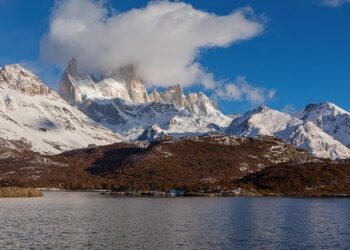Travel
Captivated as a young man by the allure of the American open road, the novelist now finds solace and inspiration walking the country’s deserts.
ByGeoff Nicholson
Published January 26, 2024
This article was produced by National Geographic Traveller (UK).
The memories of my first encounter with the California desert are so clear and intense that sometimes I wonder if I invented them, but I don’t believe so. I was hitchhiking across the States — it was the 1970s — and I was a young Englishman ‘on the road’, having read too much Jack Kerouac. My lift dropped me at a gas station near Barstow, a city in the Mojave Desert, in the south of the state. The car was air-conditioned and as I got out, I was hit by a wall of heat as strange and thrilling as anything I’d ever experienced.
I was wearing a cotton T-shirt, and I went into the petrol station’s bathroom to drench it in water, then went out looking for a place to hitch. By the time I found one, the T-shirt was completely dry. It was a learning experience, proving that the desert has to be treated with huge respect. It isn’t a monster, it won’t bite you, but it does demand that you’re on your mettle.
That was the start of a long relationship with the American desert, chiefly the Mojave, especially Joshua Tree National Park, Yucca Valley and Death Valley. I’d always lived in cities and done lots of urban walking, but the moment I set foot in the desert I knew it was a very special place for me. Nothing in the English landscape moved me the way it did.I began to make regular desert trips and for a decade and a half I lived in Los Angeles. I had many reasons for moving there, but the fact that I could be in that landscape in a couple of hours was a large part of the attraction.
Walking is the way I experience and explore the desert, although, of course, a reliable 4WD helps in getting there. I don’t claim to be some great explorer. I find an appealing stretch of desert, and I walk there. And if I find wonders such as petroglyphs, an abandoned gold mine or, say, the Noah Purifoy Desert Art Museum of Assemblage Art, then so much the better.
Cliches abound regarding the desert — that it’s a place of stillness, silence, emptiness. But, only up to a point. It is also a place of winds and shifting contours, sometimes of low-flying military planes, and although it’s in some sense empty, once you start looking, every plant, every rock, every jackrabbit is a source of fascination.
There’s isolation and solitude, but sometimes you meet fellow travellers. I was once in Stovepipe Wells, in Death Valley, setting off into the wilds, when I met a huge, imposing man who asked, “So how do you like my desert?”. I said I liked it very much and didn’t argue about whether or not it was his. Then he said, “If you walk on concrete for too long you start to think like a predator.”
I had no answer to that and went on my way. Undoubtedly, I’ve done a lot of walking on concrete, but I don’t think I’m a predator. And when I’m in a particularly bleak stretch of desert I sometimes feel like prey.
That name, Death Valley, is as accurate as it is dramatic, and lately it’s had special resonance for me. A few years ago, I was there at the Ubehebe Crater, a half-mile-wide, over-700ft-deep cavity. I decided to walk around the rim, a route described by the National Park Service as ‘moderately difficult’. I could cope with that — or so I thought. I’d done it in previous years and found it comfortable, but this time it was agony. I didn’t give up because you can’t when you’re halfway round the rim of a volcanic crater, but by the end I was exhausted, heart pounding, gasping for breath.
At the time, I accepted this as just another symptom of getting old. But in due course, having been thoroughly checked out by both US and English doctors, it was concluded that I’m suffering from CMML (chronic myelomonocytic leukemia), a rare type of blood cancer, although not rare enough, obviously. I was told it was ‘treatable but not curable’. I currently take weekly injections of a hormone that stimulates red blood cell production and allows the blood to carry more oxygen. The prognosis isn’t great. At some point, the leukemia will change from chronic to acute, at which point I’ll be in real trouble.
In some strange way this condition has inspired me, and led me to write Walking on Thin Air, a book about my walking experiences, often in the desert. I do get dog-tired sometimes, but I still walk and I still write. They’re the things I do, that I’ve always done, and I’ll continue as long as I possibly can.
Published in the Jan/Feb 2024 issue of National Geographic Traveller (UK).
To subscribe to National Geographic Traveller (UK) magazine click here. (Available in select countries only).
>>> Read full article>>>
Copyright for syndicated content belongs to the linked Source : National Geographic – https://www.nationalgeographic.com/travel/article/geoff-nicholson-hitchhiking-through-american-deserts































